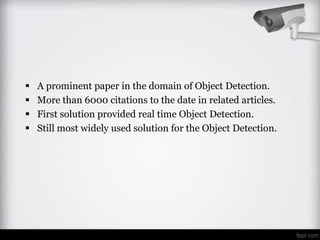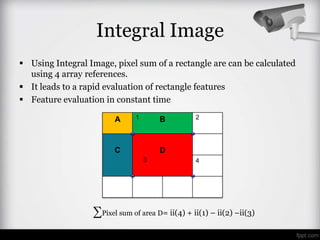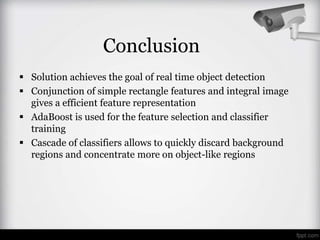Rapid object detection using boosted cascade of simple features
- 1. Rapid Object Detection using a Boosted Cascade of Simple Features Authors: Paul Viola and Michael Jones Presented by: Hirantha Pradeep Weerarathna Supervisor: Dr. Anuja Dharmaratne University of Colombo School of Computing
- 2. Authors Paul Viola – Got PhD in 1995 from MIT – Current Designations: • Manger, Architect, Developer, and Researcher at Microsoft • Professor at MIT – Research Interests are Machine Learning, Web Search and Image Processing
- 3. Authors Michael Jones – Got PhD from Massachusetts Institute of Technology in 1997 – Currently senior member in MERL Research – Research Interests are Computer Vision and Machine Learning
- 4. Road Map − Introduction − Key Contributions − Results and Comparisons − Conclusion
- 5. A prominent paper in the domain of Object Detection. More than 6000 citations to the date in related articles. First solution provided real time Object Detection. Still most widely used solution for the Object Detection.
- 6. Object detection Detecting instances of semantic objects of a certain class (such as humans, buildings, or cars) in digital images and videos. ~wikipedia.org Applications: Robotic Applications Surveillance Systems Sports Applications Security Systems And many more..
- 7. Face Detection Determining the locations and sizes of human faces in arbitrary images. ~wikipedia.org
- 8. Image Representation Represent and classify images based on simple features rather than pixels directly. Reasons are: 1. Feature can encode ad-hoc domain knowledge that is difficult to learn using finite quantity of training data. 2. Feature based systems operates much faster than pixel based systems.
- 9. Features Three kinds of simple features are used. 1. Two-Rectangles features 2. Three-Rectangles features 3. Four-Rectangles features Feature value Calculation ∑pixel values in white area - ∑pixel values in gray area
- 10. Key Contributions Three main contributions 1. Introduction of Integral Image 2. Learning algorithm based on AdaBoost 3. Combine Classifiers in Cascade
- 11. Integral Image This concept was first introduced with this solution framework. Integral Image is computed from an image using few operations on pixels. y y 10 20 10 20 10 30 40 60 20 10 10 10 30 60 80 110 x 30 10 10 20 x 60 100 130 180 10 20 30 20 70 130 190 260 Original Image Integral Image
- 12. Integral Image Using Integral Image, pixel sum of a rectangle are can be calculated using 4 array references. It leads to a rapid evaluation of rectangle features Feature evaluation in constant time A 1 B 2 C D 3 4 ∑Pixel sum of area D= ii(4) + ii(1) – ii(2) –ii(3)
- 13. Learning Algorithm based on AdaBoost AdaBoost is used for feature selection and classifier training Capable of selecting a small set of good features from a large number of feature set AdaBoost use a set of weak learners to form a strong one It guarantees that training error of the strong classifier reach zero exponentially in number of rounds
- 14. Learning Algorithm based on AdaBoost A weak learner select a single rectangle feature which best seperates positive and negative examples Weak learner determines the optimal threshold function, such that misclassification is minimized
- 16. Combine Classifiers in Cascade Building cascade of classifiers, Increase detection performance Rapidly reduce computation power Simpler classifiers apply early and reject majority of sub windows, then apply complex classifiers to achieve low false positive Subsequent classifiers are trained using examples, which pass through all the previous stages
- 17. Combine Classifiers in Cascade Cascade Training process involves two trade-offs 1. Classifier with more features will achieve higher DR and lower FPR 2. Classifier with more features need more computations Can define a optimization framework in which 1. Number of classifier stages 2. Number of features in each stage 3. Threshold of each stage Minimum number of features are selected such that, expected DR and FPR are achieved
- 18. Combine Classifiers in Cascade Simple framework is used to produce effective cascade which is highly efficient 1. User selects maximum acceptable FPR and minimum acceptable DR per each stage 2. User selects target overall FPR and DR 3. Each stage is trained by adding features until the target DR and FPRs are met 4. Stages are added until the overall target for DR and FPR are met
- 19. Results Testing has done on MIT+CMU test set, which consists with 507 faces in 130 images Using a cascade of 38 layers Cascade has trained using 4916 facial images and 9544 non-facial images Testing has been done with scaling factor of 1.25 and windows shifting scale of 1.0 on images On a conventional Pentium III machine with 700Mhz processor. They have achieved Detection Speed of 15 frames/sec
- 20. Results
- 21. Results ROC Curve for Face Detector
- 22. Results Detection Rate Comparison of Cotemporary Solution
- 23. Conclusion Solution achieves the goal of real time object detection Conjunction of simple rectangle features and integral image gives a efficient feature representation AdaBoost is used for the feature selection and classifier training Cascade of classifiers allows to quickly discard background regions and concentrate more on object-like regions
Editor's Notes
- #6: -replace word ‘prominent’-**Still most widely ..** **First solution ..** -they says solution capable of processing 15 frames/s in conventional pentium III machine
- #8: -Paper describes objects detection solution using the application of FD.-
- #13: -value of location A is sum of the pixels values in rectangle A and so on-Therefore we can calculate the sum of the pixels value in location D as value in location 4 + so on..
- #17: With respect to imageA positive result from the first classifier…
- #18: ** can define..**. Finding this optimum is extremely difficult.
- #20: **15 frames/sec** which was a 600 times speeder than contemporary solutions.
- #22: -Detector run using step size 1.0 and starting scale of 1.0-Drawn by removing classifier layers























